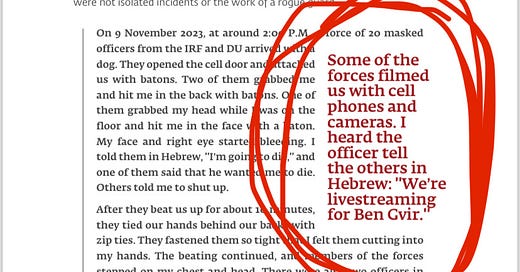B’Tselem report, Welcome to Hell: The Israeli Prison System as a Network of Torture Camps (p. 88)
Recent months have seen the emergence of harrowing footage from Israeli prisons, depicting extreme acts of violence and torture against Palestinian detainees. One particularly disturbing video, released by an Israeli news channel, shows Israeli soldiers assaulting a Palestinian male hostage at the Sde Teiman torture camp. This footage, while horrifying on its own, is part of a broader, systematic strategy to dehumanize Palestinian men and desensitize the public to ongoing atrocities. This phenomenon fits into the framework of the Axis of Genocide Voyeurism, which examines the role and impact of passive observation and desensitization to genocidal acts by external actors.
The Incident and Its Broader Implications
The footage from the Sde Teiman torture camp is not an isolated case but a piece of a larger, more sinister puzzle. The B’Tselem report, “Welcome to Hell: The Israeli Prison System as a Network of Torture Camps,” provides comprehensive documentation of systemic abuse. Testimonies from prisoners reveal a deliberate and methodical use of torture, humiliation, and psychological warfare aimed at breaking the spirit of Palestinian detainees.
One chilling account from the report describes how Israeli forces filmed their brutal acts on cell phones and cameras, explicitly stating, “We’re livestreaming for Ben Gvir”. This indicates a deliberate effort to use these recordings as a form of propaganda, aimed at normalizing and even glorifying the abuse of Palestinian prisoners.
The Axis of Genocide Voyeurism
Media Consumption and Desensitization
The release of such footage plays directly into the first component of the Axis of Genocide Voyeurism—media consumption and desensitization. Frequent exposure to graphic images and videos of violence, torture, and killings can lead to desensitization, reducing the emotional impact and urgency for intervention. The footage of Palestinian men being tortured is sensationalized, treating atrocities as spectacles rather than human tragedies, thereby diminishing the perceived severity and urgency of the situation.
Passive Observation and Inaction
The global audience, including governments and international organizations, may become passive observers, feeling overwhelmed or detached, leading to inaction or delayed responses to genocidal crises. Continuous exposure to genocidal acts can normalize violence, making it seem like an inevitable or unchangeable aspect of the world, reducing the impetus for preventive or corrective measures.
Perpetuation of Stereotypes and Dehumanization
The media’s portrayal of Palestinian men in such dehumanizing contexts perpetuates harmful stereotypes, reducing them to mere objects of violence. This fits into the third component of the Axis of Genocide Voyeurism—the perpetuation of stereotypes and dehumanization. By dehumanizing the victims, the media reinforces societal prejudices and justifies genocidal actions, stripping away the humanity of those who suffer and making their pain appear less significant.
Economic and Political Exploitation
The dissemination of such footage can also serve economic and political interests. Certain entities, including media companies and political groups, may exploit the suffering of genocide victims for financial gain or political leverage. This detracts from genuine efforts to address the root causes and provide meaningful assistance, fitting into the fourth component of the Axis of Genocide Voyeurism—economic and political exploitation.
Systematic Abuse and Torture
The testimonies in the B’Tselem report paint a grim picture of life for Palestinian prisoners. Detainees are subjected to severe physical and psychological torture, including beatings, sexual assault, starvation, and sleep deprivation. For example, one prisoner recounted how they were stripped naked, beaten, and filmed by soldiers who laughed and made degrading comments .
This abuse is not random or incidental; it is part of a systematic policy endorsed at the highest levels of the Israeli government. National Security Minister Itamar Ben Gvir has been instrumental in implementing harsh measures designed to degrade and humiliate Palestinian prisoners. These measures include reducing prisoners’ access to basic necessities like food and water, limiting family visits, and imposing severe overcrowding conditions.
The Genocidal Strategy
The dehumanization of Palestinian men through torture and media dissemination is a critical component of a broader genocidal strategy. By systematically breaking down the physical and psychological integrity of Palestinian prisoners, Israeli authorities aim to weaken the overall resistance and resilience of the Palestinian population. This approach fits into a larger framework of ethnic cleansing and population control, aimed at erasing Palestinian presence and identity.
Impacts and Addressing Genocide Voyeurism
Erosion of Empathy
Prolonged exposure to such horrific imagery and reports can lead to empathy fatigue, where individuals and communities become numb to suffering and less motivated to take action.
Reinforcement of Cycles of Violence
By failing to address the root causes and complexities of genocide, voyeurism can inadvertently reinforce cycles of violence, as the underlying issues remain unresolved.
Complicity through Inaction
Passive observation without intervention can make external actors complicit in the perpetuation of genocide, as their inaction allows genocidal acts to continue unchecked.
Conclusion
The release of footage showing the torture of Palestinian men by Israeli soldiers is not just an ethical lapse in media practices; it is a deliberate tactic in the ongoing genocide against Palestinians. This strategy of dehumanization and desensitization serves to normalize violence and diminish the humanity of Palestinian victims. It is imperative that the international community recognize these acts for what they are and hold those responsible to account.
By shedding light on these atrocities and demanding ethical media practices, we can begin to challenge the narratives that perpetuate violence and work towards justice and dignity for all victims.
This article incorporates testimonies and context from the B’Tselem report to highlight the deliberate use of media and torture as tools of dehumanization and genocide against Palestinian men, contextualized within the Axis of Genocide Voyeurism a component of a Theorem of Genocide Framework.





